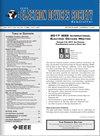具有混合 PNiO 结端接扩展功能的垂直 GaN 肖特基势垒二极管
IF 2
3区 工程技术
Q3 ENGINEERING, ELECTRICAL & ELECTRONIC
引用次数: 0
摘要
摘要 选择性面积 p 型掺杂一直被认为是垂直氮化镓结型功率器件的主要挑战之一。氧化镍(NiO)是一种天然的 p 型半导体,无需复杂的活化过程,而且电荷浓度可调,因此有可能在氮化镓功率器件中形成 pn 异质结。在这项工作中,展示了一种垂直 GaN 肖特基势垒二极管(SBD),其特点是具有氟(F)植入埋层(FIBL)的 p-NiO 混合结终止扩展(HP-JTE)。将 FIBL 嵌入 p-NiO 终止区的下方后,反向漏电流可有效降低约 3 个数量级。通过光子发射显微镜测量,还验证了 FIBL 可以有效抑制通过 p-NiO 终止区的光发射和漏电流。得益于 HP-JTE 结构和近乎理想的肖特基界面,垂直 GaN SBD 表现出了 $\sim 10^{13}$ 的高电流摆幅、$\sim 1.02$ 的低理想因子、$\sim 0.89 \mathrm{~m}$ 的低差分 $R_{O N}$ 。\Omega \cdot \mathrm{cm}^2$ ,低正向压降为 $\sim 0.8 \mathrm{~V}$ (定义为 $100 \mathrm{~A} / \mathrm{cm}^2$ ),击穿电压为 $\sim 780 \mathrm{~V}$ (定义为 $0.1 \mathrm{~A} / \mathrm{cm}^2$ )。这项工作中的表征和发现可为基于 p-NiO/GaN 异质结的功率器件提供宝贵的见解。本文章由计算机程序翻译,如有差异,请以英文原文为准。
Vertical GaN Schottky Barrier Diode With Hybrid P-NiO Junction Termination Extension
Abstract Selective-area p-type doping has been regarded as one of the primary challenges in vertical GaN junction-based power devices. Nickel oxide (NiO), serving as a natural p-type semiconductor without the requirement for sophisticated activation and enabling adjustable charge concentration, is potentially feasible to form pn hetero-junction in GaN power devices. In this work, a vertical GaN Schottky barrier diode (SBD) featuring hybrid p-NiO junction termination extension (HP-JTE) with fluorine (F)-implanted buried layer (FIBL) has been demonstrated. With FIBL incorporated underneath p-NiO in the termination region, the reverse leakage current can be effectively reduced by approximately 3 orders of magnitude. By virtue of photon emission microscopy measurements, it has also been verified that the light emission and leakage current through p-NiO termination region can be effectively suppressed by FIBL. Thanks to the HP-JTE structure as well as the nearly ideal Schottky interface, the vertical GaN SBD exhibits a high current swing of
$\sim 10^{13}$
, a low ideality factor of
$\sim 1.02$
, a low differential
$R_{O N}$
of
$\sim 0.89 \mathrm{~m} \Omega \cdot \mathrm{cm}^2$
, a low forward voltage drop of
$\sim 0.8 \mathrm{~V}$
(defined at
$100 \mathrm{~A} / \mathrm{cm}^2$
), and a breakdown voltage of
$\sim 780 \mathrm{~V}$
(defined at
$0.1 \mathrm{~A} / \mathrm{cm}^2$
). The characterizations and findings in this work can provide valuable insights into the p-NiO/GaN hetero-junction-based power devices.
求助全文
通过发布文献求助,成功后即可免费获取论文全文。
去求助
来源期刊

IEEE Journal of the Electron Devices Society
Biochemistry, Genetics and Molecular Biology-Biotechnology
CiteScore
5.20
自引率
4.30%
发文量
124
审稿时长
9 weeks
期刊介绍:
The IEEE Journal of the Electron Devices Society (J-EDS) is an open-access, fully electronic scientific journal publishing papers ranging from fundamental to applied research that are scientifically rigorous and relevant to electron devices. The J-EDS publishes original and significant contributions relating to the theory, modelling, design, performance, and reliability of electron and ion integrated circuit devices and interconnects, involving insulators, metals, organic materials, micro-plasmas, semiconductors, quantum-effect structures, vacuum devices, and emerging materials with applications in bioelectronics, biomedical electronics, computation, communications, displays, microelectromechanics, imaging, micro-actuators, nanodevices, optoelectronics, photovoltaics, power IC''s, and micro-sensors. Tutorial and review papers on these subjects are, also, published. And, occasionally special issues with a collection of papers on particular areas in more depth and breadth are, also, published. J-EDS publishes all papers that are judged to be technically valid and original.
 求助内容:
求助内容: 应助结果提醒方式:
应助结果提醒方式:


